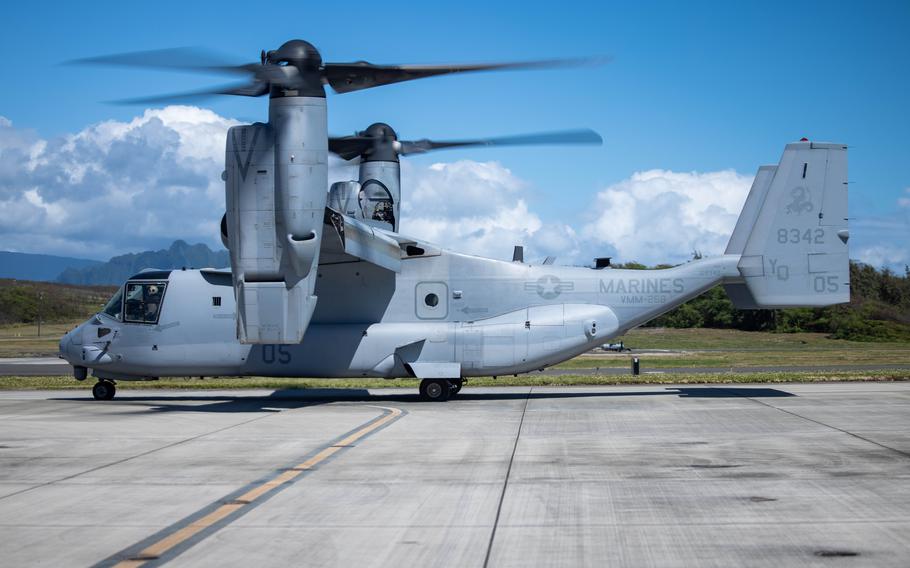
An MV-22B Osprey with Marine Medium Tiltrotor Squadron (VMM) 268, Marine Aircraft Group 24, 1st Marine Aircraft Wing, begins takeoff procedures at Marine Corps Air Station Kaneohe Bay, April 16, 2024. (Blake Gonter/U.S. Marine Corps)
The recent return to flight of the Osprey made me think back to my many experiences with the MV-22 and how transformational the aircraft has been for Marine Corps aviation.
I started flying the MV-22 in 2009. During training, I was an aircraft commander and first got to fly one of the squadron birds to Kirtland Air Force Base, N.M.
The change from the CH-46 Sea Knight was incredible. It was such a change witnessing the upgrade in speed, range and type of flying (Instrument Flight Rules at altitude, vice Visual Flight Rules down low). Requirements wise, that was exactly what the Osprey was supposed to do, and it did it magnificently.
In late December 2010 we deployed to Operation Enduring Freedom in Afghanistan, where the true beauty of the Ospreys’ speed and range could shrink an AO (Area of Operations).
Afghanistan was very “kinetic,” as most people know. It doesn’t matter how “fast” you think you are flying when down low — if you are within a weapon system’s engagement zone (WEZ), you can be hit by said weapon.
But, if you can fly higher, you are free from the effects of small- and medium-arms weapons, plus you gain better radio comms and more time to react to any surface-to-air missile threat (should one appear).
I left Afghanistan to attend Weapons & Tactics Instructor Course (WTI) in Yuma, Ariz., for a couple months and returned to the unit with a fresh perspective on Osprey employment and capabilities.
On June 12, 2011, I was the aircraft commander for a single-ship mission to resupply 1/5, as they had a unit pinned down by enemy forces in the Sangin River Valley. Earlier in the day, two ground resupply attempts received heavy IED damage and a MEDEVAC flight from the Army was also shot up, with an escort AH/UH helicopter taking a round through one of its main rotor blades.
Our squadron got the call for the resupply. With a rapid ingress to landing, our Osprey came under heavy small-arms fire as soon as it was on deck.
Squads of Marines returned enemy fire, with Bell AH/UH helos providing suppressive fire as well as rocket attacks on the enemy forces. I-Comm chatter indicated forces were being massed to move to destroy the Osprey in the zone, and they recommended an immediate egress to the West.
Once we got the last pallet off and the crew secured, we did an 80 jump with an immediate pedal turn to orient our ramp-mounted weapon system toward the enemy. The crew chief went trigger-down on the treeline containing the enemy forces. Within a few seconds, we were an airplane going 200+ KPH and were out of harm’s way.
This was a first for Marine Corps Ospreys, as we don’t generally land in hot LZs (Landing Zones) as Marines routinely did in Vietnam.
The crew and aircraft were unharmed, and the troops got their much-needed supplies. That day was the bloodiest day of Operation Enduring Freedom for 1/5 — and an MV-22 was able to bring them some relief.
Following Afghanistan, I led two more game-changing missions in the MV-22.
In the summer of 2012, I led a flight of four Ospreys from New River, N.C., to Farnborough, U.K., to participate in air shows. These were large events, and we showcased the Osprey capabilities to allies and potential foreign customers.
We flew it in three legs, flying from North Carolina to St John’s, Newfoundland, then to the Azores, and finally to the U.K., supported by KC-130s for refueling. The mission went exactly as briefed.
Finally, I concluded my 24-year Marine Corps career in 2017 by leading the first flight of four MV-22 Ospreys from Hawaii to Darwin, Australia, covering 5,000 miles of blue-water Pacific Ocean.
The first leg from Hawaii to Wake Island was about eight hours of blue water operations, with not much in the way of diverts or landing options besides the destination. Day two saw us fly about 5.5 hours to Andersen Air Force Base, Guam, and the final leg of the flight was 7.5 hours of flight time from Guam to Darwin.
Clearly a lot of details and countless hours of risk mitigation and planning went into this mission. While I had to get CMC approval back then, today missions like this are routine.
The successful completion of this mission cemented the Osprey’s ability to change how the Marine Corps can bring the fight to the enemy. Now we proved the MV-22 could range the Pacific. This was game changing, and I was honored to be a part of it.
I’ve experienced the growth of tiltrotor technology, and I have seen how vital it is for our forces to fight in the 21st century.
With the Navy getting Ospreys for the COD (Carrier Onboard Delivery) mission, and the Army bringing tiltrotor online, the platforms have a very bright future. Tiltrotor aircraft will only continue to improve through use and deployment across the spectrum of military operations.
Thomas Keech, a retired U.S. Marine Corps major, is a former MV-22B Osprey pilot who has held every Osprey qualification and instructor designation.